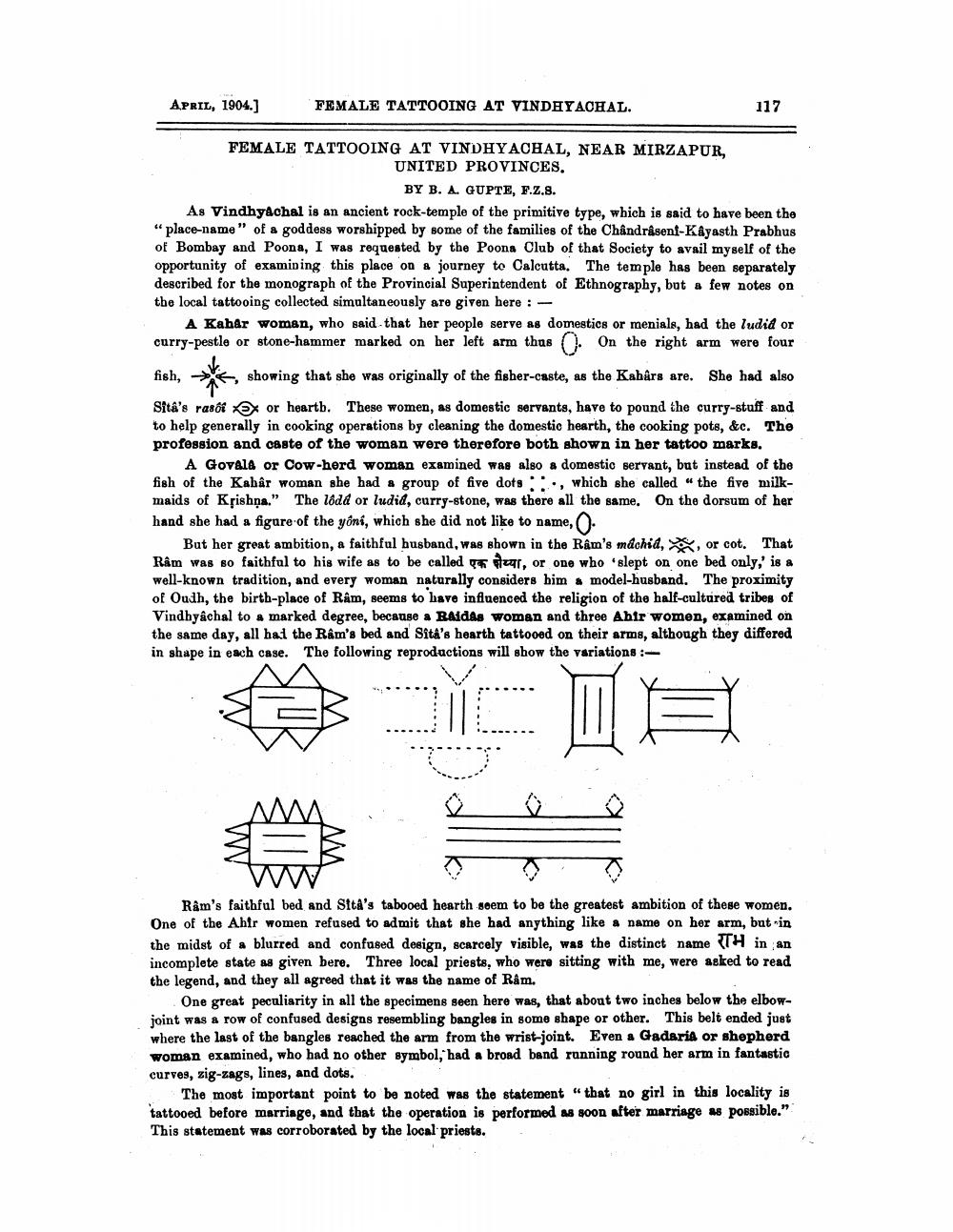________________
APRIL, 1904.)
FEMALE TATTOOING AT VINDHYACHAL.
117
FEMALE TATTOOING AT VINDHYACHAL, NEAR MIRZAPUR,
UNITED PROVINCES.
BY B. A. GUPTE, F.Z.S. As Vindhyachal is an ancient rock-temple of the primitive type, which is said to have been the “place-name" of a goddess worshipped by some of the families of the Chandrasen-Kayasth Prabhus of Bombay and Poona, I was requested by the Poona Club of that Society to avail myself of the opportunity of examining this place on a journey to Calcutta. The temple has been separately described for the monograph of the Provincial Superintendent of Ethnography, but a few notes on the local tattooing collected simultaneously are given here :
A Kahar woman, who said that her people serve as domestics or menials, had the ludid or curry-pestle or stone-hammer marked on her left arm thus ( On the right arm were four
fish, showing that she was originally of the fisher-caste, as the Kahârs are. She had also Sita's rasối x or heartb. These women, as domestic servants, have to pound the curry-stuff and to help generally in cooking operations by cleaning the domestic hearth, the cooking pots, &c. The profession and caste of the woman were therefore both shown in her tattoo marks.
A Govala or Cow-herd woman examined was also a domestic servant, but instead of the fish of the Kahêr woman she had a group of five dots , which she called “the five milkmaids of Krishna." The lodd or ludid, curry-stone, was there all the same. On the dorsum of her hand she had a figure of the yôni, which she did not like to name, O.
But her great ambition, a faithful husband, was shown in the Râm's máchid, or cot. That Râm was so faithful to his wife as to be called or, or one who slept on one bed only,' is a well-known tradition, and every woman naturally considers him a model-husband. The proximity of Oudh, the birth-place of Râm, seems to have influenced the religion of the half-cultured tribes of Vindhyâchal to a marked degree, because a Raides woman and three Ahir women, examined on the same day, all had the Râm's bed and Sita's hearth tattooed on their arms, although they differed in shape in each case. The following reproductions will show the variations :
ANNA
W Råm's faithful bed and Sita's tabooed hearth seem to be the greatest ambition of these women. One of the Ahir women refused to admit that she had anything like a name on her arm, but in the midst of a blurred and confused design, scarcely visible, was the distinct name TH in an incomplete state as given bere. Three local priests, who were sitting with me, were asked to read the legend, and they all agreed that it was the name of Råm.
One great peculiarity in all the specimens seen here was, that about two inches below the elbowjoint was a row of confused designs resembling bangles in some shape or other. This belt ended just where the last of the bangles reached the arm from the wrist-joint. Even a Gadaria or shepherd woman examined, who had no other symbol,' had a broad band running round her arm in fantastic curves, zig-zags, lines, and dots.
The most important point to be noted was the statement " that no girl in this locality is tattooed before marriage, and that the operation is performed as soon after marriage as possible." This statement was corroborated by the local priests.




